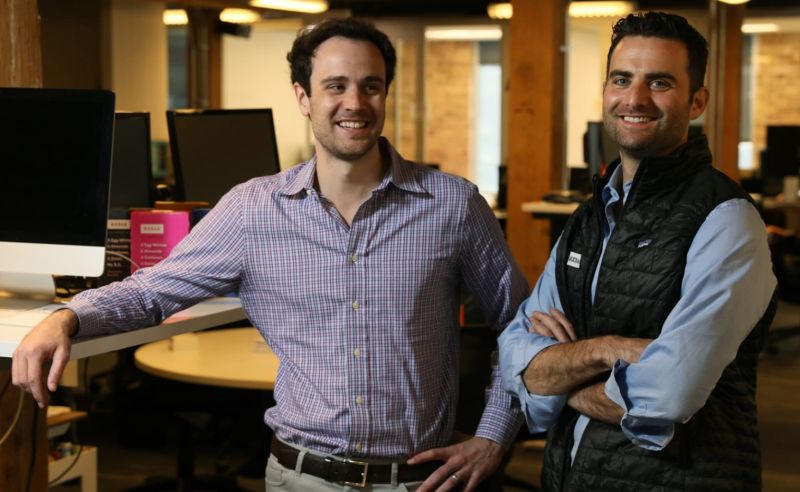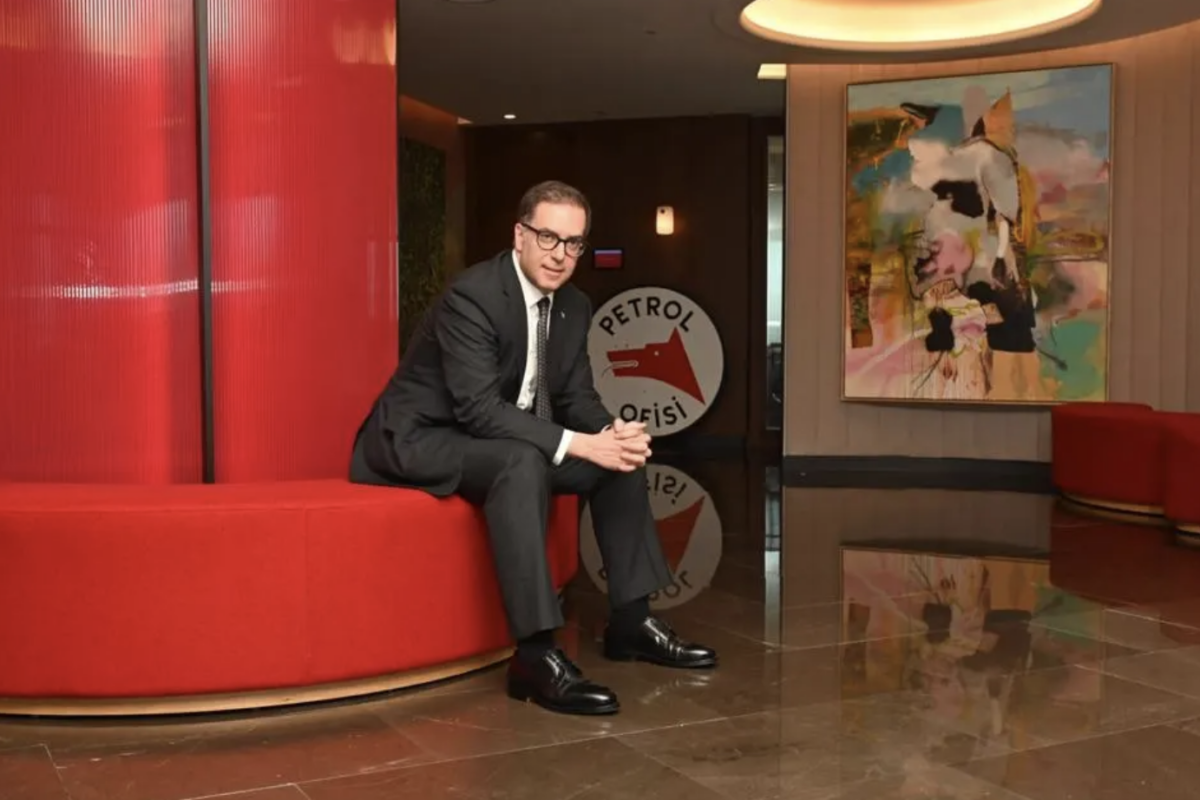We have entered an extended period of uncertainty and volatility that will likely last for 18 to 24 months. Will your organization survive….or thrive?
Leading In Uncertainty
This time of uncertainty will test the abilities of even the most skilled leaders. In response, The Blake Project has developed a program that is designed to help you navigate this time of uncertainty so that:
- Your organization thrives (not just survives)
- Your workers feel safe, heard and have a sense of connection and esteem
- There is renewed alignment around your business core as a way to drive
- Organizational performance
- Individual self-fulfillment
- Stakeholder value
The Program
Times of change and uncertainty will leave most of us feeling overwhelmed, anxious and stressed. Leaders avoid decisions. Investments are deferred and resources are hoarded. When doubt and fear drive behavior and personal agendas, leadership’s ability to drive the organization to success is stalled.
Our program enables leaders to take strategic, pragmatic action while leading with compassion and emotional steadiness. It equips managers with enhanced capabilities to keep their teams focused and productive in times of uncertainty and empower your workers to help develop priorities and make business-values based decisions with the most up-to-date information available.
We believe this time of uncertainty holds an opportunity for your organization to thrive with increased innovation, stronger stakeholder value and greater workforce performance.
Our Business Alignment: Thriving in Uncertainty program includes the following key elements.
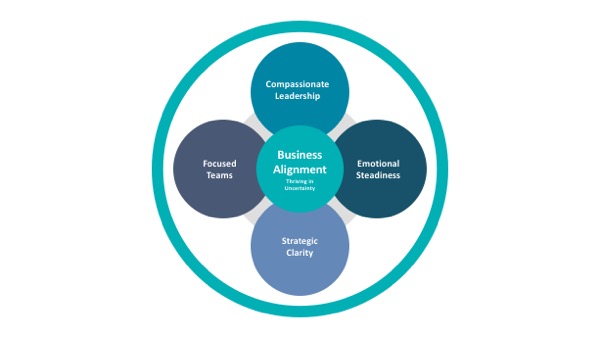
Compassionate Leadership
Studies by the Academy of Management and the Center for Positive Organizations have found that organizations with more compassionate leaders have better collaboration, lower turnover, and employees who are more trusting, more connected to each other, and more committed to the company.
Times of uncertainty can lead each of us down a path of stress. For some this may manifest as avoidance, for others it may be harsh words, or less than health indulgences like overeating or too much alcohol. When an entire organization is stressed, productivity becomes a casualty. While you can’t control the external environment, you can rely on compassionate leadership as a way to keep your teams focused and your workers feeling connected and valued.
Emotional Steadiness
Dr. Susan David of Harvard Medical School states that that “when people don’t acknowledge and address their emotions, they display lower wellbeing and more physical symptoms of stress, like headaches. There is a high cost to avoiding our feelings. On the flip side, having the right vocabulary allows us to see the real issue at hand–to take a messy experience, understand it more clearly, and build a roadmap to address the problem.” We’ve used the techniques developed at the Harvard/McLean Institute of coaching both personally and with clients for years and our experience proves these techniques will help bring emotional steadiness, even as we navigate the long-term impact of a global pandemic.
Strategic Clarity
One thing is for certain, we are in a shared state of “strategic ambiguity.” The Covid-19 pandemic and the resulting economic pause and almost certain recession mean it isn’t clear where we’re going and we’re not sure when we’ll get there. As leaders, we must help our organizations move out of strategic ambiguity and into clarity as quickly as possible. There is no way of knowing where we’ll be in 12 months or even 6 months, however, we can provide clarity around the next 30 or 45 days. The key is to engage your teams and managers in developing immediate priorities and longer-term strategies.
Focused Teams
The traditional crisis management framework outlines three phases leaders must navigate for success during a crisis:
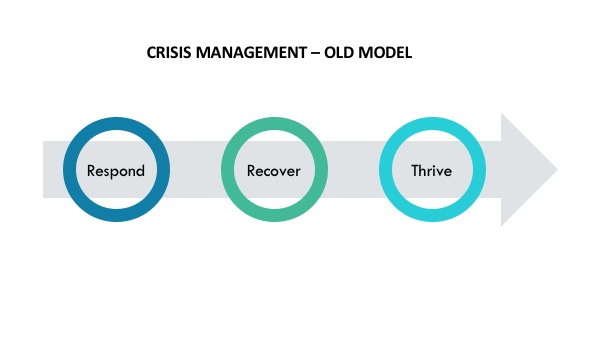
However, those who depend upon this old model for Covid-19 crisis leadership my find themselves perpetually stuck in a Groundhog Day-esque cycle of response and recovery, never able to break the cycle and reach the point of thriving. This is because:
1. An 18 to 24 month horizon for exiting the crisis means organizations will be in response mode for 18 to 24 moths. Many organizations simply don’t have the resources to survive such an extended period of responding.
2. Experts indicate we should expect to see “hot-spots” of Covid-19 intensity popping up across the United States and around the globe until there is sufficient immunity and a well-distributed vaccine. As the hot-spots emerge and wane organizations will find themselves in response and recovery mode, over and over again. This constant cycle of response and recovery will leave few resources for organizations to focus on thriving.
We propose a new model for thriving in uncertainty. This model is based upon proven techniques and enables thriving while responding, building, learning and sharing. This model embraces short-term strategies and promotes success through teams operating in sprints. It assumes both a constantly shifting operating environment and the ability to grow revenue, innovate and provide value for all stakeholders.
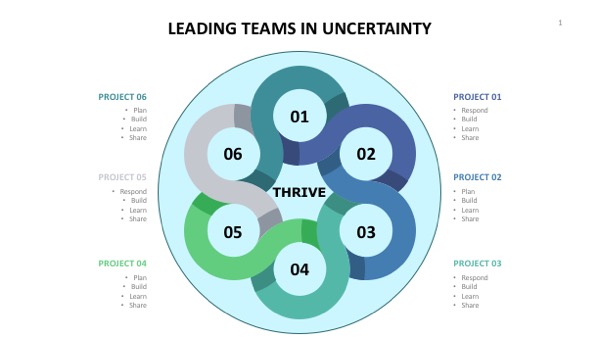
Covid-19 is layered upon an already challenging time of technology transformation for most organizations. It is not be uncommon for an organization to be leading multiple transformation projects such as cloud transformation, digital transformation, artificial intelligence and workforce transformation all at the same time. The outcomes of these projects are vital for the continued success of the organization. This model allows you to prioritize the projects that will best support your organization’s continued success while provide a process for realizing the benefits of the projects, perhaps faster than originally planned.
Research by Dr. David F. Rico has shown organizations who used these techniques realized gains between 38–100% for deadlines, 25–80% for productivity, 83% for client satisfaction and 74% for team moral. Though our approach is new, the techniques we use deliver proven results.
Business Alignment
In times of uncertainty a strong brand with a powerful shared purpose will help workers and ecosystem partners stay inspired and focused. Business values will guide decision makers as the pace of decision making increases and becomes more dispersed and the implications carry more weight. And, the business core of image, culture and vision, will signal to all stakeholders that the organization is part of the solution.
When your company culture is aligned and integrated with that your business identity, your employees are more likely to make decisions and take actions that deliver on your brand promise.
However, before leaning more deeply into the business alignment, it is important evaluate whether any elements of the business core need to be refined to meet the challenges of the current situation. By using an evaluation process that includes all stakeholders, your workers, customers and ecosystem partners will all have an opportunity to renew their commitment to your organization’s purpose, mission, vision and values.
Our business alignment process will:
- Ensure key voices are heard as we learn from successes, uncover collective strengths and discover components of your organization’s identity that are still relevant and reveal newly emerging themes.
- Collaboratively assemble and share emerging themes and stories that represent your organization’s positive core in this new environment.
- Reinforce you company’s values as they define the behaviors of the organization, particularly around stakeholder (customer, employee and ecosystem) experience and front-line decision making.
- Assess your current brand ecosystem (image, culture and vision) and develop an action plan for realignment, if needed.
- Drive c-suite collaboration and organizational alignment around business strategy.
Program Format
This program kicks-off with a 2-day online or in-person workshop, followed by periodic working sessions to allow for re-assessment of the external environment and adjustment of immediate priorities. The program enables your organization, workers and stakeholders to thrive in this time of uncertainty.
Module 1 – Pre-work
Designed to help participants surface how the Covid-19 crisis has impacted them. It encourages participants to become more aware of how their way of being in the world may have shifted and offers an easy way to assess stress levels.
At the end of this module, participants:
- Understand the importance of and are better able to take care of themselves first
- Better understand how the crisis has impacted them
- Are better able to experience self-compassion
- Have an expanded emotional vocabulary
- Better understand the effectiveness of journaling as a way to create emotional steadiness
Module 2 – Personal Alignment
Provides workers with an opportunity to share their experience of Covid-19 with their colleagues. Using the pre-work, helps workers understand how their new way of being may impact how they show-up at work. It encourages individuals to better understand what support they may need and how they can best support others.
At the conclusion of this module, participants:
- Have a greater capacity to be emotionally steady
- Better understand how the personal shifts they have experienced because of the crisis may impact how they “show-up” and work.
- Have greater clarity around how they can best support the needs of others.
Module 3 – Team Alignment
Unveils the “Focused Teams” operating approach and encourages teams to decide, “What do we want to be as a team now?, What do we need to let go of? And, what do we need to let come?” Finally, “What personal shifts are needed to support the team’s new way of being?”
At the conclusion of this module, teams and team members will:
- Have a greater sense of belonging, connection and shared purpose.
- Have a greater ability to understand the value and importance of their personal “way of being” as it impacts team cohesion and performance.
Module 4 – Brand And Strategy Alignment
Develop ground-up immediate priorities and align with C-suite revised longer-term strategy. Ensures business alignment within the context of uncertainty as a way to reaffirm worker commitment to organization purpose, company values as a way to inform decision making and c-suite collaboration and organizational alignment around business strategy.
At the conclusion of this module:
- Strategic areas of focus have been identified: Brand strengths, opportunities, aspirations and desired results
- Social Contract Statement (how you define your responsibility to all stakeholders) with an emphasis on stakeholder experience has been reconfirmed or revised.
- Moral Compass Statement (how values define the behaviors of the organization) with an emphasis on empowering new front-line decision makers has been reconfirmed or revised.
- Brand Ecosystem Assessment (Evaluation of current image, culture and vision in light of current environment) is completed and an action plan to update has been developed
- Teams better understand how to operate in sprints and embrace short-term strategies
- KPIs for team performance are created by the teams
Module 5 – Core Brand And Strategy Report Deliverables
Delivery of and actionable Core Business Report and Strategy Summary that includes Provocative Proposition statement, Organization Creed, the Critical Path forward.
At the conclusion of this module,
- Leadership has an actionable plan to bring the organization into alignment and a clear way to move forward with immediate priorities.
Module 6 – Navigating The Flow
Periodic (every 45 – 60 days) full-day team working session designed to help teams stay focused through strategic clarity, emotional steadiness and business alignment
- Encourage self-assessment of emotional steadiness and self-care
- Celebrate team successes
- Provide an opportunity for connection
- Team self-assessment of
- Team New Way of Being, what is going well, what adjustments would be helpful
- Team operational performance using KPIs
- Team assessment of Focused Teams approach, what is working, what adjustments would be helpful
- Assess current state of external environment and determine team priorities for next short sprint
- Encourage business alignment through an emotionally compelling video
At the conclusion of this module,
- Teams are more focused and productive
- Workers feel heard, connected, and have a sense of purpose and esteem
Scalability
In addition to the six core modules, we offer two training modules to support larger organizations as they scale the program.
Training Modules To Support Scalability Of The Program For Larger Organizations
Module T1 – Personal Alignment Facilitation for Managers
The training session equips managers with the necessary tools and skills training to facilitate the Personal Alignment module for small teams.
At the conclusion of this training module,
- Managers will be better able to establish and hold a safe “container” for the Personal Alignment module
- Managers will be better understand the importance of taking care of themselves first
- Managers will better understand the importance of acknowledging the uncertainty with their teams
- Managers will be better able to model and encourage self-compassion
- Managers more frequently ask people what they need
- Managers more readily focus on what they control
- Managers more frequently encourage and model self-care
- Managers will have an expanded emotional vocabulary
- Managers will be better able to quantify an emotion’s intensity
- Managers will better understand the effectiveness of journaling as a way to create emotional steadiness
Module T2 – Focused Team Leadership for Managers
In this training module, managers receive the tools and skills training necessary to lead small teams using the Focused-Teams approach of
- Small teams
- Short sprints
- Learn fast
- Share wins
- Repeat
At the conclusion of this module,
- Managers are able to lead teams that operate in sprints and embrace short-term strategies
- Managers are better able to support teams in learning fast and sharing their learning
- Managers are better able to support front-line workers as they make brand-values based decisions
- Managers are better able to help teams identify surprise wins and share them quickly
- Managers have a greater capacity to recognize and reward positive team performance
Next Steps
Please email The Blake Project for more about how this program can help your organization Thrive in Uncertainty. We can also be reached directly at 813-842-2260.
Branding Strategy Insider is a service of The Blake Project: A strategic brand consultancy specializing in Brand Research, Brand Strategy, Brand Growth and Brand Education


